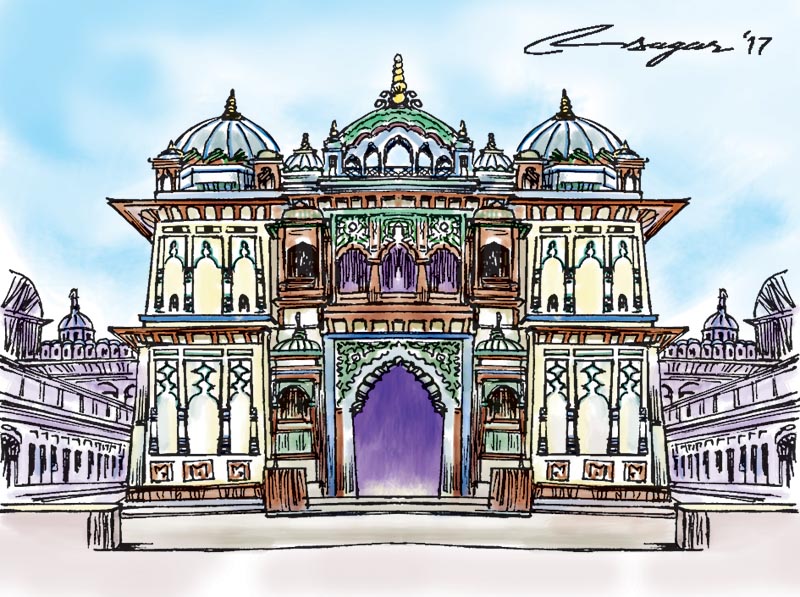Nepal-India relations: Ramayan circuit
The impact of Sita and Ram on the culture of Nepal and India is so strong that parents wants to make their son as Ram and daughter as Sita as they are ideals of our life
It is the socio-cultural rather than the political factor that determines the long-term relations between two countries. Judged from this perspective, Nepal and India relations are found to have been governed more by socio-cultural factors. This is the secrecy to the unique relations between the two countries. A beginning had been made to build and nurture this relationship by Goddess Sita, the princess of Mithila and Lord Ram, Prince of Ayodhya when they were tied through the knot of marriage in the Treta Yuga some ten thousand years ago.
The impact of Sita and Ram on the culture of Nepal and India is so strong that parents wants to make their son as Ram and daughter as Sita as they are ideals of our life. No other character on the earth has ever influenced the life of the people as much as them. Therefore, our common culture is often called Siya-Ram Sanskriti. Presently, Janakpur is in Terai region of Nepal; while Ayodhya is in the Uttar Pradesh state of India. However, the cultural and emotional ties between the people of the two countries are not confined to their boundaries.
Reflecting this deep- rooted relationship, the Janakpur-based NGO Mithila Abadh Preservation Council recently organized a two-day conference on “Ramayan Circuit and Mithila Abadh Relations” in Janakpur on the 3rd and 4th November, 2017. Participants from Nepal and India, including scholars, journalists, political activists and civil society members discussed several pertinent issues ranging from traditional relations between Mithila and Abadh, connectivity between Janakpur and Ayodhya, protection and preservation of ponds, temples and heritage of Mithila, promotion of tirthatan (tourism) in Ramayan/Sitayan circuit regions, and boosting up regional economy through the development of the twin cities of Janakpur and Ayodhya.
Significantly, the Indian government has recently included Nepal under its Leave Travel Concession (LTC) arrangement. As such, nearly five million central government employees of India who enjoy grant of leave and ticket reimbursement facilities under LTC while travelling in India could also get such facilities if they travel to Nepal.
Over and above, there is immense potentiality to attract the state government employees to conduct tirthatan/tour to these regions. Additionally, of the total population of 1.32 billion (2016) in India, over 80 percent people are Hindus. It is a dream for many of those people to visit Janakpur-Ayodhya in their lifetime.
Sita-Ram Lok Sansikritik Yatra could also be organized between Janakpur and Ayodhya on Janaki Naumi day, the birthday of Sita and/or Ram Naumi Day, the birthday of Ram to seek greater participation of the common mass of the population in this event.
Such Yatra could touch those spots between Ayodhya and Janakpur through which Ram came to Janakpur during his swayambar (marriage) with Sita. Similarly, the Yatra could also be conducted through that trail through which Sita and Ram returned to Ayodhya from Janakpur after their swayambar.
In order to encourage tirthatan/tourism industry in the region, such events as Janakpur Mahotsav could be organized in Ayodhya and Ayodhya Mahotsav and in Janakpur each year. Through such activities, the local food, dress, dance, songs, handicrafts, apart from the publications/manuscripts on the life of Sita and Ram, could be exchanged between the two places. Besides, both the Janakpur and Ayodhya municipalities could make efforts to get the twin city agreement between Janakpur and Ayodhya renewed.
The twin city agreement was signed at the government level between Nepal and India for three years at the initiative of Indian Prime Minister Narendra Modi when he visited Nepal for the second time in 2014. Provisions had been made in the agreement for the development of infrastructural facilities, including roads, education, and hygiene and sanitation sectors.
Unfortunately though, due to the lack of political “will” on the part of the political leaders and passive attitude of the bureaucracy in both the countries, the dream project for the development of Janakpur and Ayodhya could not roll further. But now a new Mayor has been elected in Janakpur and Ayodhya is experiencing resurgence in the spiritual sector. So these two municipalities could work with added zeal to execute twin city agreements once it is renewed.
The Mayors of Janakpur and Ayodhya could also share experiences from Chandra Babu Naidu, the Chief Minister of Andhra Pradesh, who is developing a new capital, Amaravati. Since Janakpur is also likely to emerge as the capital of Pradesh No. 2 in the federal set up in Nepal, the visit to Amaravati would be a great event for these Mayors.
As Sita and Ram serve as the foundation for Nepal-India relations, it is needed to focus on connectivity between Janakpur and Ayodhya, apart from developing them as twin cities. Such activities will not only enlighten the people spiritually, but it would also help promote socio-cultural relations between the two countries.
The entire regions in the stretch of 622 kilometres distance between Janakpur and Ayodhya are likely to develop, particularly in agriculture, industrial, transport and tourism sectors, once the Ramayan/Sitayan circuit project is materialized.
Jha is Executive Director of Centre for Economic and Technical Studies in Nepal






